The Samsung 750 EVO (120GB & 250GB) SSD Review: A Return To Planar NAND
by Billy Tallis on April 22, 2016 8:00 AM ESTAnandTech Storage Bench - The Destroyer
The Destroyer is an extremely long test replicating the access patterns of very IO-intensive desktop usage. A detailed breakdown can be found in this article. Like real-world usage and unlike our Iometer tests, the drives do get the occasional break that allows for some background garbage collection and flushing caches, but those idle times are limited to 25ms so that it doesn't take all week to run the test.
We quantify performance on this test by reporting the drive's average data throughput, a few data points about its latency, and the total energy used by the drive over the course of the test.
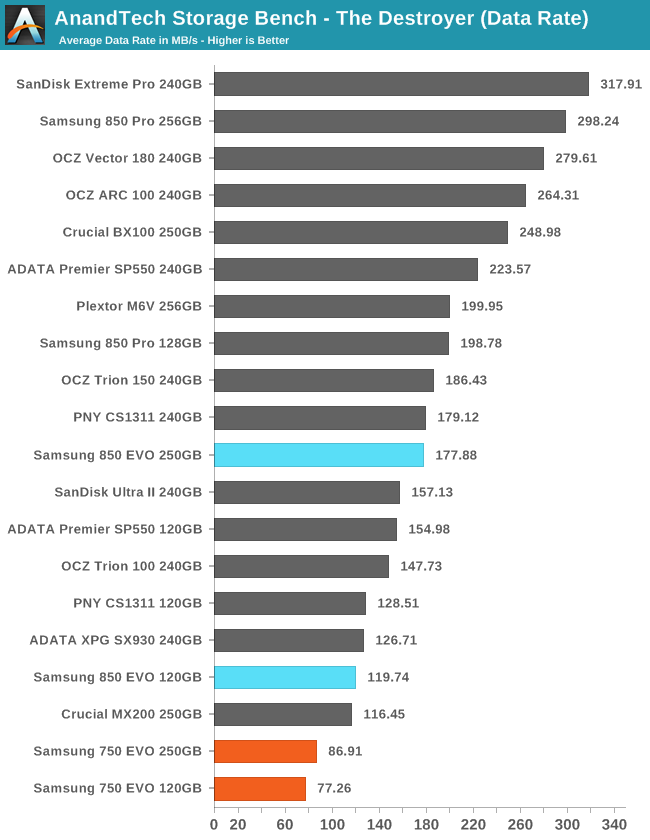
The Destroyer has earned its name here. The 750 EVO is clearly the slowest modern SSD on this test, showing that it is not suitable for sustained intense workloads with a high volume of writes. Almost any other SSD currently on the market will perform better under pressure, including competing TLC drives.
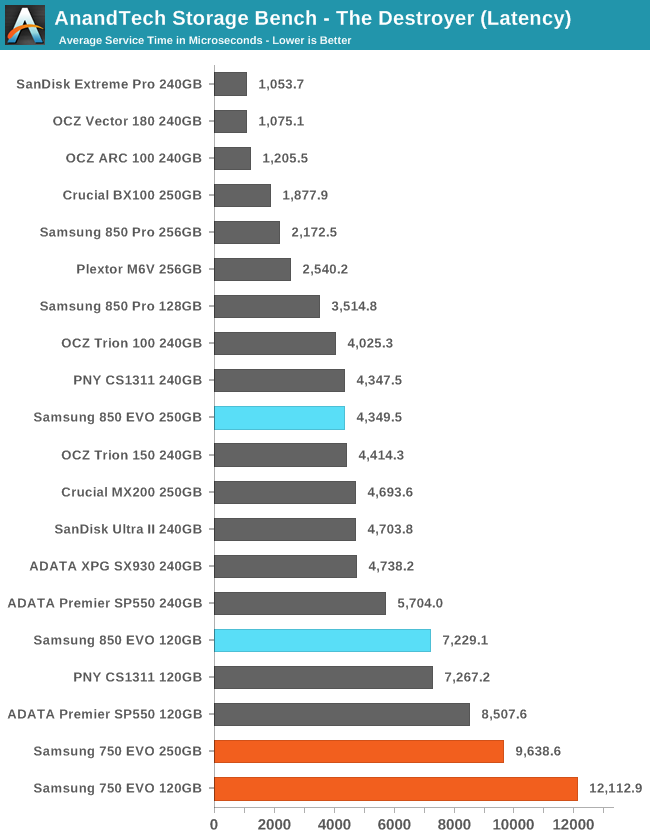
The 750 EVO also sets new records for slow responses, with average service times on par with standard hard drive seek times. Though since The Destroyer has an average queue depth of about 5.5, a mechanical hard drive would still be several times worse by this metric. Conversely, the best MLC SSDs are almost ten times quicker than the 750 EVO.
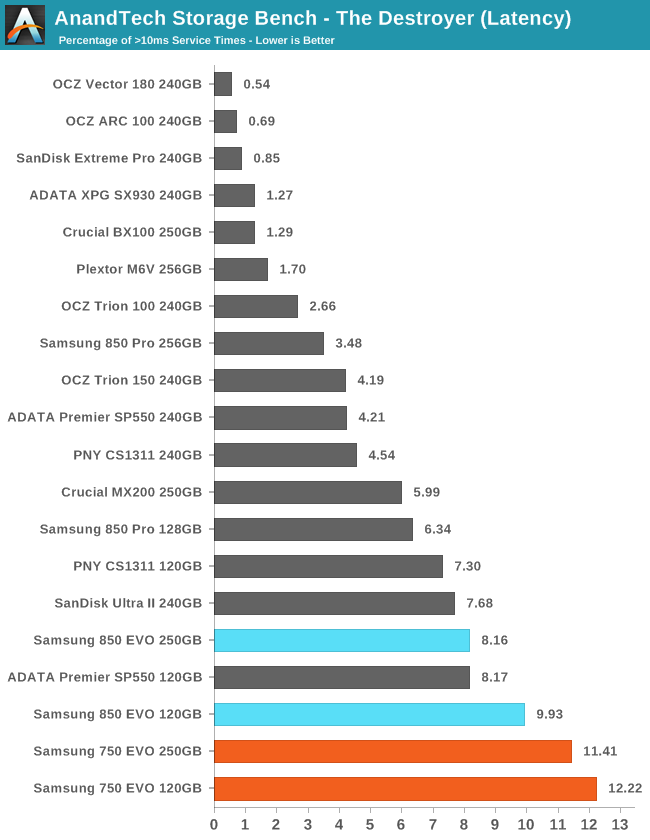
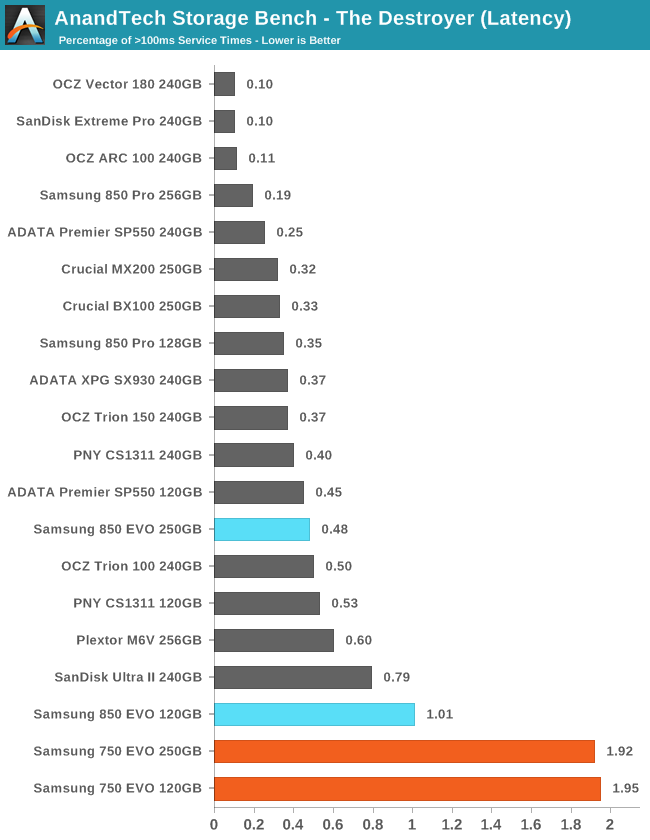
With over 10% of operations taking more than 10ms, we can't quite refer to them as outliers anymore. At the 100ms threshold, the 750 EVO has twice as many outliers as anything else.
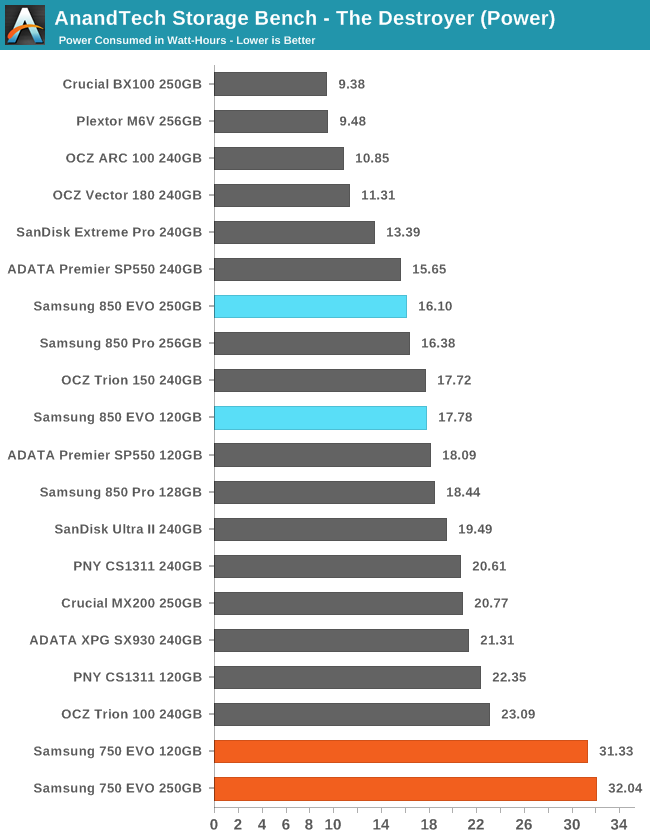
The substantially higher energy usage of the 750 EVOs is a straightforward consequence of them taking much longer than everything else to complete the test: The 120GB 750 EVO took just over 17 hours to complete this test while the 120GB PNY CS1311 took only 13.5 hours and the 128GB 850 Pro needed only 10 hours.










109 Comments
View All Comments
lilmoe - Friday, April 22, 2016 - link
Meh. I'll wait until it's half price.haukionkannel - Friday, April 22, 2016 - link
Well, this is 10$ cheaper that 850evo, so this will be very popular among system builders and other with tight budget. Normal upgrade user will definitely go for 850. But this is good enought to most customers.Space Jam - Friday, April 22, 2016 - link
$10 for considerably worse performance does not a winner make.I have a hard time swallowing the cheapo, terrible performance $60 TLC drives. If Sammy thinks anything more than $65 is a good price they have another thing coming.
$60 for a budget 120GB SSD is some audacity.
I and most others will stick to BX100s @ $70 and 850 EVOs @ $75 during the (frequent) sales.
jabber - Friday, April 22, 2016 - link
And if it's upgrading a lot of the older machines desktops and laptops that still only run on SATA II...it doesn't matter. As long as it pushes 285MBps (ish) all day that's all it needs. A lot of kit out there is still SATA II.Alexvrb - Friday, April 22, 2016 - link
Yeah it's got a sequential speed cap. Not all tasks are about peak speeds. I'm pretty sure in terms of IOPS a decent SSD will still beat the snot out of an OEM-grade penny-pinching budget model, even on old SATA 2. Which brings us back to the idea that this is for OEMs and builders - truly this is a "builder-grade" component. If you're upgrading or building for yourself, you'll likely pay a few extra bucks for an 850 Evo or similar unit.With that being said, any of the modern SSDs are better than a mechanical drive. Blech.
leexgx - Wednesday, April 27, 2016 - link
this drive will likely be perfect for the older apple laptops that have that dodgy cable that does not support SATA 3 but the controller does (the cable fails if a high speed cable is used) i had to use a DVD HDD caddy on number of apple laptops due to that issue where it will not detect the SSD or HDDleexgx - Wednesday, April 27, 2016 - link
high speed drive is used (not cable is used) edit be nice on here but that's unlikelyDeath666Angel - Friday, April 22, 2016 - link
I'm guessing the marketing value for "Performance Samsung SSD inside" is considerably higher than comparable Sandisk or Crucial SSDs. And the 10 bucks off compared to the 850 means the margins remain. And if current 1TB laptop drives get replaced by these 250GB 750s, I think everyone is a winner. :DSamus - Monday, April 25, 2016 - link
It's funny you mention that because I would prefer a Sandisk or Crucial/Micron drive over a Samsung anyday.Have you ever tried warranting a Samsung drive? They are hell to deal with. And yes, I still have a sour metallic taste after the 840 Evo debacle that essentially was never fixed.
I also think Crucial/Sandisks Marvell drives, albeit slower, are more consistent, stable and deal with power loss substantially better than the MGX. The fact Samsung is making an SSD with 35TBW endurance in 2016 is pretty damning. I've seen 20GB racked up on old Intel X25-M's in a matter of years so 35GB in a 5 year period isn't out of the question. Just about any other SSD or hard disk for that matter will handle double that no problem at the rated capacity.
vladx - Monday, April 25, 2016 - link
" after the 840 Evo debacle that essentially was never fixed."Don't know what you mean, I also have a 840 EVO and can confirm the performances issues are gone after the 2nd fix.